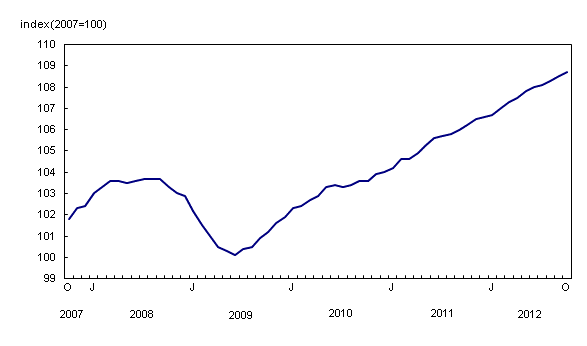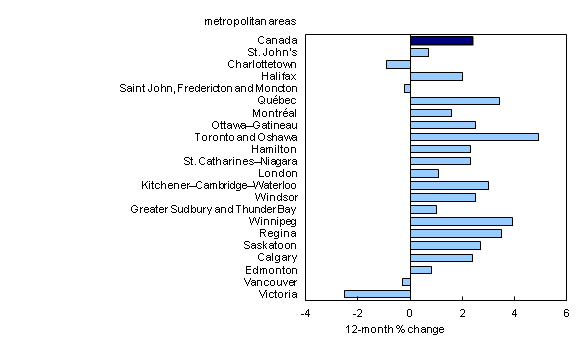New Housing Price Index, October 2012
Archived Content
Information identified as archived is provided for reference, research or recordkeeping purposes. It is not subject to the Government of Canada Web Standards and has not been altered or updated since it was archived. Please "contact us" to request a format other than those available.
Related subjects
-
[an error occurred while processing this directive]
The New Housing Price Index (NHPI) rose 0.2% in October, following similar increases throughout the year.
New Housing Price Index

Chart description: New Housing Price Index
The combined metropolitan region of Toronto and Oshawa, as well as the region of Montréal, were the top contributors to the advance. In Toronto and Oshawa, market conditions were the primary reason for higher prices. In Montréal, the main factors were higher material and labour costs as well as new building code requirements.
The largest monthly price advance in October occurred in Hamilton (+0.8%), followed by Winnipeg which recorded a 0.5% increase. In Hamilton, builders reported new higher list prices. In Winnipeg, the rise was primarily the result of an increase in the cost of material and labour.
Prices were unchanged in 11 of the 21 metropolitan regions surveyed in October. Monthly prices declined 0.2% in Charlottetown as a result of lower negotiated selling prices, and decreased 0.1% in the combined metropolitan region of Sudbury and Thunder Bay as a result of lower lot prices.
Toronto and Oshawa posts the highest year-over-year price increase

Chart description: Toronto and Oshawa posts the highest year-over-year price increase
On a year-over-year basis, the NHPI rose 2.4% in the 12 months to October, following a similar increase the previous month. The main contributor to the advance was the combined metropolitan region of Toronto and Oshawa, where the year-over-year-increase in contractors' selling prices was 4.9%. It was followed by a 3.9% increase in Winnipeg.
Other significant year-over-year increases occurred in Regina (+3.5%) and Québec (+3.4%).
Among the 21 metropolitan regions surveyed, 4 posted 12-month price declines in October. The largest decrease was in Victoria (-2.5%).
Note to readers
The New Housing Price Index measures changes over time in the selling prices of new residential houses agreed upon between the contractor and the buyer at the time of the signing of the contract. It is designed to measure the changes in the selling prices of new houses where detailed specifications pertaining to each house remain the same between two consecutive periods. The prices collected from builders and included in the index are market selling prices less value added taxes, such as the Federal Goods and Services Tax or the Harmonized Sales Tax.
The provincial government of British Columbia introduced legislation on May 14, 2012, announcing the return to a provincial sales tax on April 1, 2013. From April 1, 2012, until March 31, 2013, there are new housing transitional rebates in place. After the transition is complete, the provincial sales tax on building materials in British Columbia will be embedded in contractors' selling prices of new houses. These changes will be reflected in the New Housing Price Index as reported by respondents.
The indexes are not subject to revision and are not seasonally adjusted.
Available without charge in CANSIM: table CANSIM table327-0046.
Definitions, data sources and methods: survey number survey number2310.
The third quarter 2012 issue of Capital Expenditure Price Statistics (Catalogue number62-007-X, free) will be available in January 2013.
The New Housing Price Index for November will be released on January 10, 2013.
For more information, or to enquire about the concepts, methods or data quality of this release, contact us (toll-free 1-800-263-1136; infostats@statcan.gc.ca) or Media Relations (613-951-4636; statcan.mediahotline-ligneinfomedias.statcan@canada.ca).
- Date modified:
